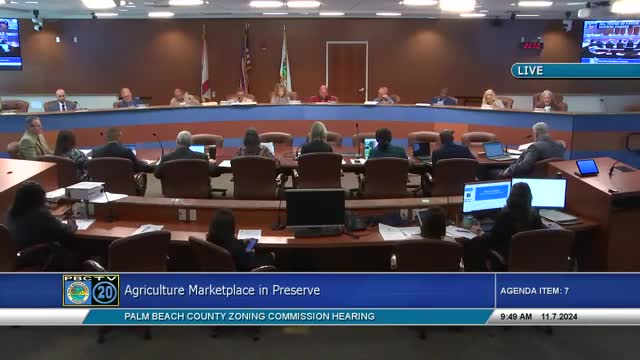Palm Beach County modifies flood damage prevention ordinance post FEMA policy update
November 08, 2024 | Palm Beach County, Florida
This article was created by AI summarizing key points discussed. AI makes mistakes, so for full details and context, please refer to the video of the full meeting. Please report any errors so we can fix them. Report an error »

The Palm Beach County government meeting held on November 8, 2024, focused on proposed modifications to the Unified Land Development Code (ULDC) concerning the flood damage prevention ordinance. The meeting featured presentations from the building division, specifically Doug Wise and Jackie Anderson, who outlined necessary changes mandated by the Federal Emergency Management Agency (FEMA) following updates to flood maps.
The discussion began with an overview of FEMA's February 2020 policy, which redefined how agricultural and non-habitable accessory structures are classified within the National Flood Insurance Program (NFIP). The policy stipulates that these structures, if enclosed or partially enclosed, must be elevated or dry flood-proofed rather than wet flood-proofed. Wet flood-proofing allows water to enter and exit the building, while dry flood-proofing involves making the structure watertight.
Wise explained that the proposed changes to Article 18 of the ULDC would require a variance for any agricultural or non-habitable accessory structure seeking to utilize wet flood-proofing. This adjustment aims to enhance compliance with FEMA standards and improve flood safety.
Additionally, the meeting addressed modifications to the community rating system, which incentivizes floodplain management practices. Palm Beach County currently holds a Class 5 rating, and changes are necessary to maintain this status. The updates include revised foundation and elevation requirements for manufactured buildings, as mandated by a January 2021 addendum to the CRS coordinator's manual.
The Florida Building Code was also discussed, particularly regarding size limitations for non-habitable accessory structures eligible for wet flood-proofing without a variance. The county plans to adopt new coastal flood hazard designations, including areas subject to moderate wave action, and will implement the same performance standards for these zones as for high wave velocity zones.
The meeting concluded without further comments from the commission, indicating a consensus on the proposed changes. The modifications aim to align local regulations with federal requirements, ensuring enhanced flood resilience for Palm Beach County's structures.
The discussion began with an overview of FEMA's February 2020 policy, which redefined how agricultural and non-habitable accessory structures are classified within the National Flood Insurance Program (NFIP). The policy stipulates that these structures, if enclosed or partially enclosed, must be elevated or dry flood-proofed rather than wet flood-proofed. Wet flood-proofing allows water to enter and exit the building, while dry flood-proofing involves making the structure watertight.
Wise explained that the proposed changes to Article 18 of the ULDC would require a variance for any agricultural or non-habitable accessory structure seeking to utilize wet flood-proofing. This adjustment aims to enhance compliance with FEMA standards and improve flood safety.
Additionally, the meeting addressed modifications to the community rating system, which incentivizes floodplain management practices. Palm Beach County currently holds a Class 5 rating, and changes are necessary to maintain this status. The updates include revised foundation and elevation requirements for manufactured buildings, as mandated by a January 2021 addendum to the CRS coordinator's manual.
The Florida Building Code was also discussed, particularly regarding size limitations for non-habitable accessory structures eligible for wet flood-proofing without a variance. The county plans to adopt new coastal flood hazard designations, including areas subject to moderate wave action, and will implement the same performance standards for these zones as for high wave velocity zones.
The meeting concluded without further comments from the commission, indicating a consensus on the proposed changes. The modifications aim to align local regulations with federal requirements, ensuring enhanced flood resilience for Palm Beach County's structures.
View full meeting
This article is based on a recent meeting—watch the full video and explore the complete transcript for deeper insights into the discussion.
View full meeting